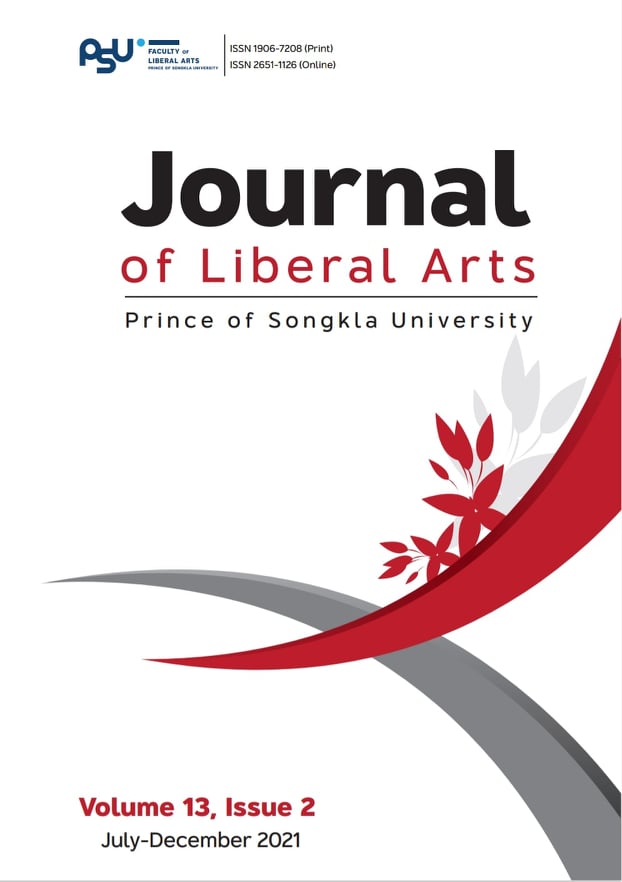Implementation for Teaching Thai Literature as a Foreign Language Based on Literature Approach and Five Steps for Student Development Technique for Middle School Students in International School
DOI:
https://doi.org/10.14456/jlapsu.2021.2Keywords:
Implementation of the Literature-based Approach, Teaching Thai as a Foreign Language, Five Steps for Student Development Technique, Visible Thinking RoutinesAbstract
This article is an academic article that compiles knowledge and ideas from academic documents and teaching experience in international schools. This article aims to propose learning and teaching guidelines for teaching Thai as a foreign language by using the literature-based learning which can be applied to Thai as a foreign language course in international schools. The author suggests guidelines for learning and teaching Thai as a foreign language by using Thai literature and the Five Steps for Student Development Technique consisting of 1. Learning to Question, 2. Learning to Search, 3. Learning to Construct, 4. Learning to Communicate, and 5. Learning to Serve, and activities based on Visible Thinking Routine, the process of structured thinking, following the Constructivism Theory. As a result of the implementation of these teaching approach guidelines, students are encouraged to learn to deepen their understanding of the meaning and participate more in the classroom and develop their critical thinking skills.
References
Babaee, R., & Wan Yahya, W. (2014). Significance of Literature in Foreign Language Teaching. Canadian Center of Science and Education, 7(4), 80-85.
Custodio, B., & Sutton, M. (1998). Literature-Based ESL Secondary School Students. TESOL Journal, 7(5), 19-23.
Daskalovsk, N. (2012). Why should literature be used in the Language classroom. Procedia-Social and Behavior Sciences. 46(2012), 1182-1186.
Duff, A., & Maley, A. (1991). Literature. Oxford University Press.
Floris, F. (2004). The Power of Literature in EFL Classrooms. Petra Christian, 6(1), 1-12.
Goodman, K. (1986). What’s whole in whole language? Heineman.
Grace, P. (2021). MYP by Concept Individuals and Societies. Hoddereducation.https://www.hoddereducation.co.uk/curriculum
Greene, A. (2019). Literature and Language Acquisition: Benefits and Challenges. University College London.
Hopfenbeck, T. (2020). IB students ‘appear to hold an advantage’ in critical thinking, finds study. Independent Education today. https://www.hoddereducation.co.uk/
International Baccalaureate. (2016). The International Baccalaureate® (IB) Middle Years Programme (MYP) is for students aged 11-16. https://www.ibo.org/programmes/middle-years-programme.
Kamnet, W. (2015). Teaching Thai in 21 Century. http://wutthiphong khamnet.blogspot.com/2015/06/five-steps-for-student-development.html [in Thai]
Kanchanakhuha, W. (2015). Document on 2nd National Conference on Language Thai Literature and Teaching Thai as the Foreign Language. Learning and Creating from Thai society to World society. Srinakharinwirot University. [in Thai]
Khamanee, T. (2015). The Science of Teaching. Chulalongkorn Press. [in Thai]
Kolius, M. (2021). Making Thinking LL for HS [Power Point slides]. Thai Teacher’s Meet Conference [in Thai]
Krashen, S.D. (1985). Principles and practices of second language acquisition. Pergamon Press.
Lazor, G. (1993). Literature and Language Teaching. Cambridge University Press.
Limbach, B., & Waugh, W. (2010). Developing higher level thinking. E-Journal of Instructional Pedagogies. http://www.aabri.com/manuscripts/09423.pdf
Magirius, M. (2018). Constructivism in literature Education: Introduction to the Thematic Binder. L1-Educational Studies in Language and Literature, 18, 1-12. https://doi.org/10.17239/L1ESLL-2018.18.05.01
Mckay, M. (1987). Literature in the ESL Classroom. (Edition2). Oxford University Press.
Pleangson, R. (2018). The science of teaching Thai as a foreign language. Chulalongkorn Press. [in Thai]
Pongpajon, C. (2019). Designing Thai lesson by using Literature Approach: Concept Guideline and essential topic. Manutsayasat Wichakan, 26(2), 95-125. [in Thai]
Project Zero. (2016). Thinking Routines. http://www.pz.harvard.edu/projects/visible-thinking
Sam, D., & Amos, P. (2017). The effectiveness of literature on acquisition of language skills and intercultural understanding in the high school context. University College London. https://www.ibo.org/contentassets/ 1fcefe0df17448bebe6781ea0396adff/effect-of-literature-on-language- acquisition-final-report.pdf
Soferman, L. (2016). Literature-Based vrs. Controlled-Vocabulary Approach for Beginning Readers. https://eric.ed.gov/?id=ED571529.
Sumai, B. (2015). Skills and Competency of Teachers and Students in 21 Century. https://drsumaibinbai.wordpress.com [in Thai]
Wilén, O. (2016). How ESL Teachers Use English Literature in the Classroom. http://www.diva- portal.se/smash/get/ diva2: 1057292/FULLTEXT01.pdf
Downloads
Published
How to Cite
Issue
Section
License
Copyright (c) 2021 Suchaya Santivarakom, sira somnam, Jarunee Tippayamonton

This work is licensed under a Creative Commons Attribution-NonCommercial-NoDerivatives 4.0 International License.
The authors retain the copyright to their article but the Journal of Liberal Arts, Prince of Songkla University reserves the exclusive rights to first publication.






